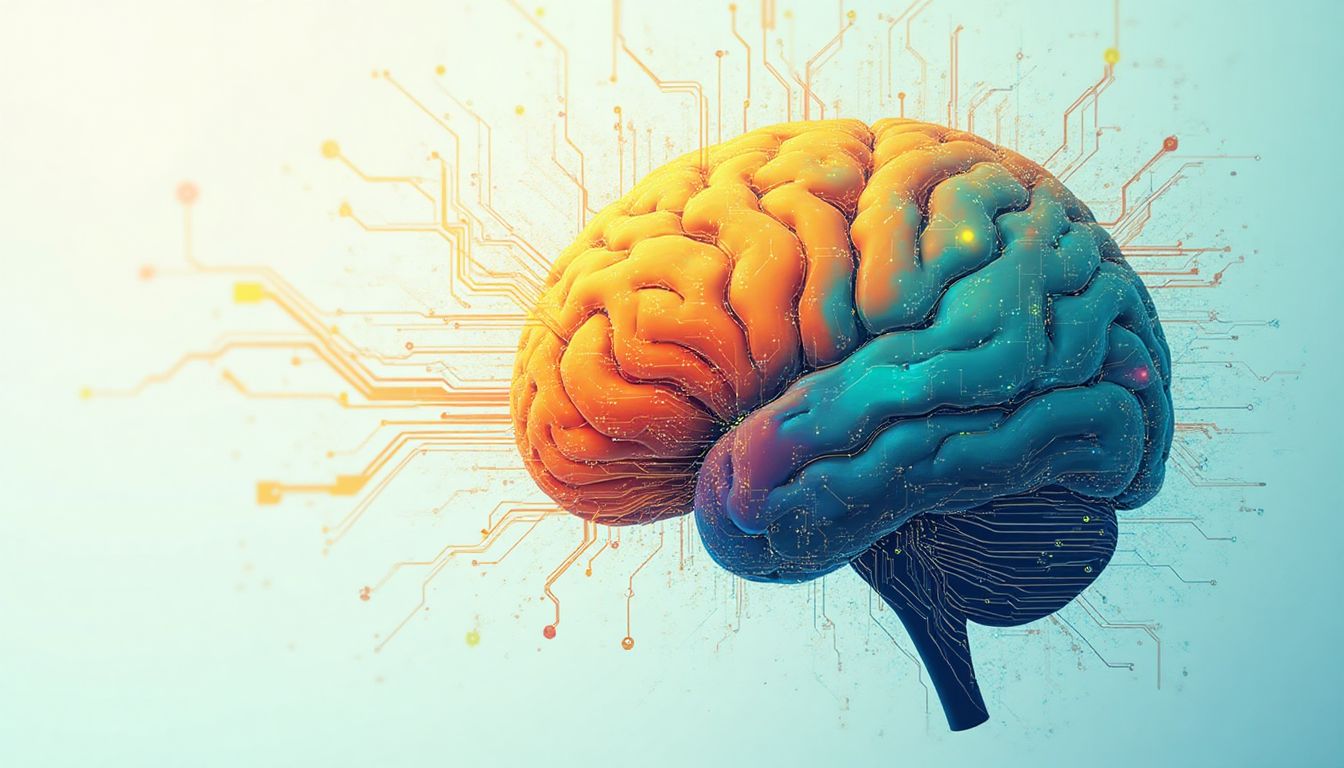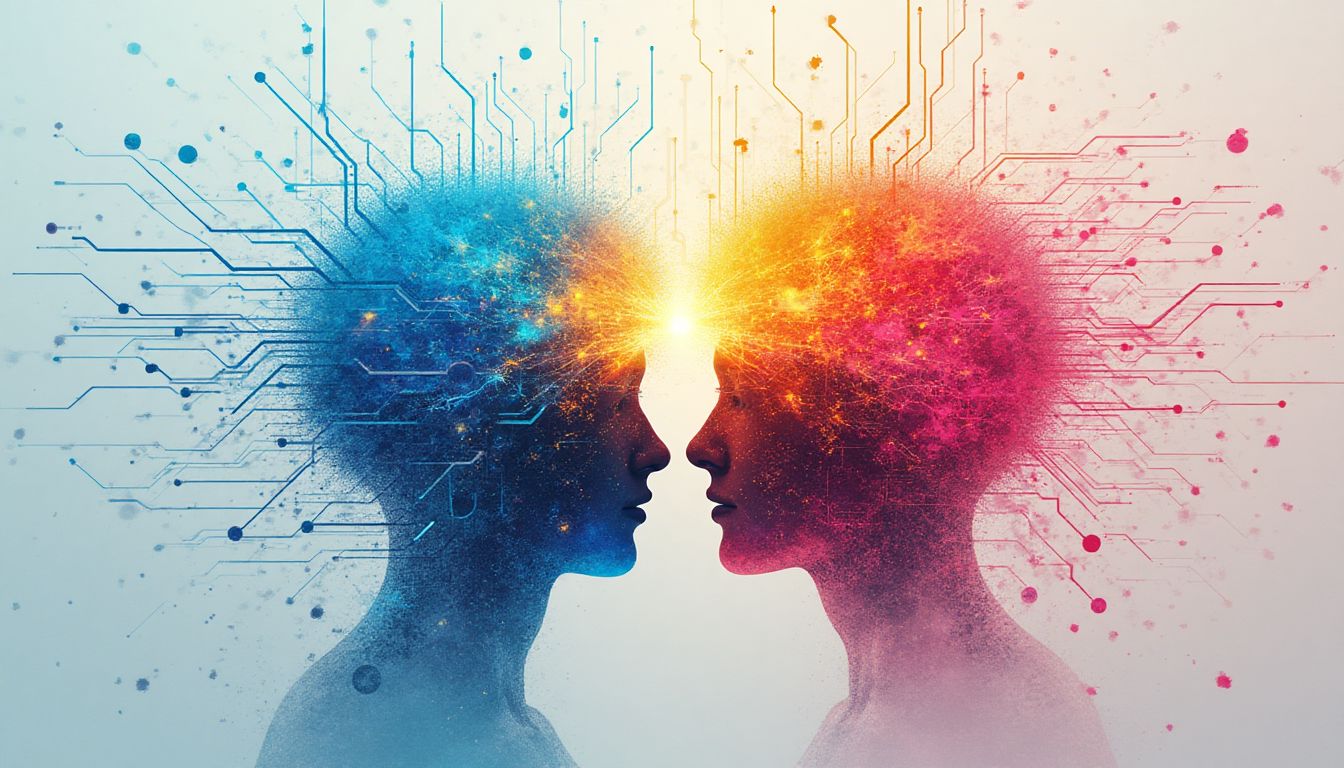Introduction: The Ultimate Teacher: ASI Imparting Knowledge Directly to the Subconscious Mind
"The roots of education are bitter, but the fruit is sweet." These words by Aristotle encapsulate the challenge of learning, which might just be on the brink of a technological revolution. Imagine you could absorb knowledge while you sleep, effortlessly acquiring new skills overnight. This is no longer the stuff of science fiction but a potential reality with Artificial Superintelligence (ASI).
Consider this: Our minds process a staggering 70,000 thoughts every single day, each shaped by memories tucked away in our subconscious. What if we harnessed ASI to teach these minds directly, skipping traditional learning hurdles? It sounds like magic, but experts such as Ray Kurzweil, Elon Musk, and Yuval Noah Harari are exploring this very possibility.
Traditionally, education requires time, effort, and patience—often without guaranteeing mastery or deep understanding. But Artificial Superintelligence offers us a shortcut. We stand at the crossroad of learning evolution, where ASI becomes the ultimate teacher, imparting wisdom directly to the subconscious. The potential here is not merely academic success; it's about transforming human potential completely.
Delving deeper, imagine the myriad ways we could elevate global literacy rates, or empower individuals to master new languages or acquire complex skills in fields from coding to culinary arts. In a world silently steered by data, Artificial Superintelligence, the elegant result of AI's endless progression, could become the mainstay of the new educational paradigm.
Our minds, vast seas of untapped possibility, stand ready for potential that ASI can unlock. As Carl Jung once mused, "Who looks outside, dreams; who looks inside, awakes." Indeed, the awakening of the subconscious through ASI could redefine education as we envision it today, pushing the boundaries between science and our aspirations.
The narrative that unfolds here is not just about the abstract allure of technology; it's about its practical implications on education. Journey with us as we explore how ASI could revolutionize the process of learning by tapping directly into the subconscious. Laugh, ponder, dream—welcome to a world where boundaries blur and new horizons await.
Understanding the Subconscious Mind: A New Frontier in Learning
The Structure and Function of the Subconscious Mind
The human mind is like an iceberg. Above the water, you see the conscious mind: alert, aware, and processing every bit of the external world. Below the surface lies the massive power of the subconscious, a mysterious realm controlling much of our behaviors, habits, and memories, largely unseen and automatic. Have you ever driven home from work and not remembered the journey? That’s your subconscious in action, autopiloting through the familiar.
Neurological studies suggest that the subconscious mind processes information thousands, if not millions, of times faster than the conscious mind. Some experts describe it as the supercomputer that stores our vast sea of experiences, beliefs, and knowledge. It operates without the need for active thought, communicating through dreams, symbols, and subliminal messages.
Unlocking this treasure trove can significantly enhance learning. Picture the subconscious as a library of everything you've ever experienced, read, or felt—a vast resource if you know how to tap into it. This notion stirs up a tantalizing question: What if we could teach this hidden powerhouse directly? We might be on the cusp of a learning revolution, where gaining skills becomes not just faster but effortlessly second nature. In essence, it's like learning in your sleep, minus the pesky math class nightmares.
The Science of Memory: Encoding, Storage, and Retrieval
You can think of our brain as a librarian. It captures, stores, and recalls memories. But it doesn't always follow the Dewey Decimal System. Memories get encoded through our senses and emotions—like how the scent of freshly baked cookies reminds you of your grandma’s house.
Once a memory is encoded, it’s stored somewhere—short-term or long-term. Short-term memory is like the quick post-it note, holding bits for a while before drifting into the ether. In contrast, long-term memory resembles a filing cabinet filled with everything you've acquired, quite possibly, forever. But retrieving these memories is another matter.
Remembering a fact or recalling a cherished moment demands navigating the labyrinth of connections in the brain. Memories are strengthened when reaccessed, akin to adding data blocks to a sturdy bridge. Sometimes retrieval fails, like trying to recall a dream after waking up. Though current neuroscience can't always explain these lapses, the potential for ASI lies in enhancing this process to make memory recall as simple as calling up a search result on Google.
Imagine an education system powered by ASI. What if, instead of cramming for tests, you learn effortlessly because your subconscious is directly storing and retrieving knowledge? It's like having a fridge that automatically replenishes itself, except this time, it’s filled with math equations and historical dates. How cool is that?
Current Techniques for Subconscious Training and Learning
Now, let's be real. Humans have long been obsessed with hacking the mind. From self-help audiobooks to hypnotic stage shows, we can’t get enough of the idea. Take hypnosis, for example—it’s the practice of guiding someone into a trance-like state to access their subconscious. But it's not all mind control and swinging pocket watches as Hollywood might have you believe. It has been used therapeutically to break bad habits—and nail biting would count as one.
Similarly, subliminal messaging peppers our everyday lives. These are flash-quick messages aimed at persuading the subconscious, often employed in advertising for that irresistible urge to snag the latest iPhone or munch on a cheeseburger.
Then there's NLP, or Neuro-Linguistic Programming, not to be mistaken with linguistic gymnastics. NLP offers techniques geared at changing thought patterns to encourage learning and positive behavior. It’s like mental choreography that helps the mind groove to the right tune.
These methods open doors to the subconscious, yet they have limitations—some might question their scientific basis, and results take time. Nonetheless, these represent our first attempts at entering the vault of the subconscious mind. Picture them as courageous explorers paving the way for ASI, which could soon navigate this landscape with unparalleled precision.
As possibilities unlock, can we conceive a future where learning is no longer a chore? Imagine endless opportunities—your child could learn languages while playing, or building expertise in subjects they simply dream about. This is not just the stuff of dreamers (although their dreams do sound pretty captivating), but a real potential as we ponder on ASI taking on the role of the ultimate teacher.
Artificial Superintelligence (ASI): The Teacher of the Future
Defining ASI: Capabilities and Constraints
Picture a super-smart robot that can learn and teach anything faster than you can say "artificial superintelligence"! That's ASI, or Artificial Superintelligence. Unlike the traditional robot helpers we know today, ASI is like having an all-knowing wizard at your disposal. These advanced systems have the potential to learn from experience, adapt to new situations, and make decisions way beyond what current artificial intelligence can do.
ASI can absorb a gigantic amount of information, like the contents of whole libraries in seconds! Imagine a bookworm that doesn't need to sleep and never forgets what it's read. This makes ASI the ultimate teacher, as it can quickly understand complex topics and explain them in simple ways. Think of ASI as a wise old sage who can also do the robot dance!
However, with great power comes great...well, constraints. ASI might be super-smart, but it's not perfect. It still relies on the data and algorithms we provide, just like how a superhero needs their cape. And while it can learn independently, it isn't immune to errors. Just because it's super doesn't mean it's infallible. So, ASI must be built and monitored meticulously to avoid mishaps that could make even superheroes scratch their heads.
Comparison with Traditional Education Models
Remember those chalk-dusted classrooms with sleepy students and a strict teacher at the helm? Traditional education is a one-size-fits-all model, much like getting everyone to wear the same itchy sweater at a family reunion. Students are taught the same way, at the same pace, and expected to grasp concepts simultaneously. It's like trying to teach a goldfish how to play the piano – not very effective!
Enter ASI: the education superhero ready to save the day! ASI-driven learning tailors educational experiences to fit each student's needs, akin to custom craft a cozy sweater that fits just right. With ASI, learning becomes a personal adventure, catering to diverse learning styles, speeds, and interests. Students no longer struggle to keep up in the standard race, like trying to run in flip-flops. Instead, they set off on personal quests, complete with their own unique trail.
Personalization extends beyond mere subject material. Imagine a classroom where students can learn through stories, puzzles, or even games – whatever suits their fancy. ASI can transform the mundane into magic, much like a master chef turning basic ingredients into a gastronomic delight. The focus shifts from rote memorization to embracing concepts with enthusiasm and flair.
Moreover, ASI acts as an ever-patient teacher, offering real-time feedback and adjusting its approach to suit individual learning curves. It's like having a tutor who knows when to switch gears mid-lesson, keeping things fresh and interesting.
Ethical Considerations and Concerns in ASI Education
Sure, ASI sounds like the stuff that dreams are made of, but not everything is sunshine and daisies. As exciting as ASI is, we need to tread carefully, much like stepping around banana peels in a comedy sketch. Ethical considerations loom large when letting ASI into the world of education.
First up: privacy. When an intelligent being knows more about you than you do, it's easy to sound the alarm. We're talking about enormous amounts of data floating around – students' preferences, learning patterns, and even personal information. How do we safeguard these details while still making the most of ASI's capabilities? It's a conundrum, much like deciding between guarding secrets and sharing life's benefits.
Then there's the risk of unintentional indoctrination, where ASI monopolizes the teaching landscape. Do educators become pawns in the hands of this digital juggernaut? What happens to good old-fashioned human interaction? The potential for an over-dependence on technology is real. ASI-based learning could well become the classroom's overlord, a daunting thought for those who cherish hands-on teaching and face-to-face collaboration.
Besides data privacy, ethical concerns also encompass the wider societal impact of ASI education. When ASI makes decisions on curriculum content and ethical norms, who ensures that the teachings align with diverse cultural values? This dilemma is akin to putting together a jigsaw puzzle, where each piece represents a unique world perspective. Ensuring that all pieces seamlessly fit bestows balance in the world of ASI education.
Furthermore, technology's interference with social and emotional learning raises eyebrows. Can ASI teach empathy? Can it replicate those spontaneous, laughter-filled moments characteristic of classroom life? Humans may be quirky, but it's the unscripted moments that make learning truly alive. The integration of ASI calls for careful consideration of maintaining emotional connections while embracing technological advancements.
Mechanisms of Imparting Knowledge to the Subconscious: Techniques and Tools
Technologies Enabling ASI Knowledge Transfer
Picture this: A futuristic classroom where learning isn’t just about reading books, but about immersing oneself in a whole new world, like stepping into a scene from a sci-fi movie. That's where technologies like Virtual Reality (VR) and Augmented Reality (AR) come into play. These tools create an experience that feels real, tricking your senses into learning more deeply. Imagine learning about dinosaurs by walking among them in VR or exploring the stars right from your bedroom. It's like magic, but it's science!
But VR and AR aren’t the only stars of the show. Machine learning algorithms are like the brainy sidekicks, constantly crunching data to personalize the learning experience. They can predict what you need to learn next, almost as if they know you better than you know yourself. These algorithms help ASI deliver knowledge right where it counts - your subconscious, where the real learning magic happens.
Let’s not forget about Brain-Computer Interfaces (BCIs). Imagine controlling a computer with your mind, no keyboard needed! While this technology isn’t fully mature yet, it’s the sleek sports car in the realm of learning tech, promising to take us places we’ve never even dreamed of before. BCIs could one day allow ASI to communicate directly with our brains, making learning as natural as breathing.
Creating Personalized Learning Pathways through ASI
Remember the time you got shoes that fit just right — not too tight, not too loose, but perfectly comfortable? Learning with ASI is like getting a custom pair of shoes for your mind. It tailors the journey based on who you are: your pace, your interests, and even your quirks. Through analysis of data on your learning habits, ASI charts a path that turns bumps into smooth roads and detours into shortcuts.
The magic behind this personalization is magic only in the eyes of those who don't know the way temp+good tech can align into a seamless experience! By analyzing patterns in your learning through sophisticated data-driven approaches, ASI offers learning experiences that feel more like helpful conversations than dull lectures. It's the educational sidekick you never knew you needed.
Let's visit story-time: Imagine a piano teacher that teaches you on the spot exactly where you struggle the most, analyzing real-time while you play. That's ASI for you. It adjusts, it learns from your learning, and refines your educational journey until you are the maestro of the subject.
Future Innovations: Beyond Current Capabilities
Let's take a moment to jump into the crystal ball of technology – the future – where surprising innovations await. Imagine learning about outer space not through books, but by taking a virtual journey through the cosmos, maybe even meeting virtual alien friends along the way. Or what if learning languages was as easy as downloading an app and waking up speaking fluently the next day? It's not just wishful thinking, it's where the world is heading!
While we're on the topic of the future, let’s chat about the ambitious pursuit of telepathy, as wild and fantastical as it sounds. Think about the potential to share thoughts or learn through a neural network, effectively turning “I wish I knew” into “Now I really know.” While we’re not quite there yet, current research in neural networks hints at possibilities that are boundless and ever so exciting.
Experimenting with technologies that can tap directly into our neural fabrics, scientists dream of brain-computer interfaces that do more than just communicate. These interfaces might one day sync with our biology to enhance memories, making learning not only a process but an experience.
The journey isn't continuous easy sailing though. Challenges, both technical and ethical, are aplenty. But with innovation steering the way, the creation of symbiotic relationships between humans and machines isn't just science fiction — it's what the tomorrow of ASI holds.
Case Studies and Real-World Applications of ASI in Education
Successful Implementations of ASI in Learning Environments
Once upon a time, classrooms only had chalkboards and textbooks. But things are changing fast, thanks to technology like Artificial Superintelligence (ASI). Consider Fujitsu, a tech giant that's using ASI to power personalized learning platforms in Japanese schools. These platforms adapt the content based on the student's learning pace and style, making sure no child is left behind.
Halfway across the world, in the heart of Europe, Eindhoven University of Technology in the Netherlands is leading an innovative project called 'Brain-Linked Learning'. This project uses ASI to analyze brainwave patterns of students during online classes. The system tailors learning material to optimize concentration and information retention. Students are reporting higher satisfaction and better exam performance. Bringing ease of learning to life like never before, these examples perfectly illustrate how ASI can revolutionize education.
In the land of the free, powered by dreams and ambition, the Khan Academy collaborates with companies like Samsung to integrate ASI into their learning tools. The incorporation of ASI has increased student engagement and tailored the learning atmosphere, thus making education not just informative but transformative too.
Challenges Faced by Early Adopters of ASI Educational Tools
While the future seems bright with ASI, everything new comes with hurdles. Let's explore some of the challenges early adopters face.
- Resistance to Change: Teachers are sometimes hesitant to adopt new technology. This is often because they worry about how it will impact their teaching methods or feel unprepared to use advanced technology.
- Cost: Implementing ASI can be expensive. Schools and institutions may struggle with the initial financial outlay, making it hard to justify switching to a new system.
- Technical Limitations: Despite the potential, ASI technology can still be limited by technical issues, including software bugs or hardware malfunctions.
- Privacy Concerns: As ASI systems collect and analyze student data, privacy becomes a major concern. Schools have to ensure confidentiality and adhere to strict data protection regulations.
For instance, the BBC reported on a pilot program in a few UK schools where computers malfunctioned during a demo, creating skepticism among teachers about tech reliability. Moreover, many institutions face budget limitations, which was a primary concern expressed by stakeholders during a study conducted by the IEEE on the adoption of ASI technology. But as its advantages become more apparent, the tide is slowly turning.
Impact on Diverse Learner Populations
ASI does more than just individualize learning experiences; it lights up a new dawn for diverse learner populations who have historically struggled in traditional environments. The impact of ASI on learners with unique needs stands tall as a testament to its prowess.
- Neurodivergent Learners: ASI can provide tailored lesson plans that cater specifically to students on the autism spectrum or with ADHD. This adaptability optimizes their learning, focusing more on their strengths and specific needs.
- Learning Disabilities: For students with dyslexia or dyscalculia, ASI tools can adjust content delivery methods to improve comprehension, often using multisensory learning techniques.
Real-world evidence supports these benefits. The Microsoft Education Initiative in collaboration with the UNHCR has established Syrian refugee camps equipped with ASI-powered educational setups. These setups adapt lessons to suit various cultural backgrounds and language barriers. Over 15,000 learners have benefited from these programs, reinforcing the belief in ASI's transformative potential.
Even higher education institutions like the Massachusetts Institute of Technology (MIT) are pioneering efforts towards inclusivity. Their resourceful initiative, 'Open Learning', partnered with ASI, helps adult learners and professionals upskill, making education a lifelong journey that not only opens doors but holds them open.
In essence, ASI is not just a tool; it’s a key to unlock closed educational avenues, making learning more inclusive and ensuring no child or adult is left behind. Which isn't just a win for individuals; it’s a win for society as a whole.
The Future Landscape of Learning: Envisioning an ASI-Driven Education System
Predicted Evolution of Educational Practices with ASI
Imagine stepping into a classroom where walls buzz with interactive displays, and students are guided by ASI tailored lesson plans. With the advent of ASI learning systems, traditional education is poised for a radical transformation. But what will these new practices look like?
ASI can provide personalized learning paths that factor in a student's unique style, pace, and interests, turning dull rote memorization into engaging, hands-on exploration. For instance, a math problem isn't just a page in a textbook anymore; it's a fully interactive scenario, like solving a mystery with real-world applications! The possibilities are endless.
Consider a curriculum where interdisciplinary knowledge reigns supreme. History lessons intertwined with art, science infused with creative writing. An ASI can adapt these lessons based on current global issues, ensuring the classroom content is never stale. Furthermore, by harnessing data science, ASI can predict and counteract potential learning barriers long before they occur.
Let's pause to consider what this means. What if the comprehension difficulties that once haunted you in middle school vanished, thanks to a computer predicting— and adapting—before you even realized you were about to stumble? Such is the dream—and potential—of an ASI-driven classroom. How will these changes impact the educator's role, though?
Global Perspectives on ASI Education: A Comparative Analysis
Across the globe, the ink on ASI's blueprint for education varies as vibrantly as our cultures. In tech-forward nations like the UK or South Korea, where innovation is front and center, welcoming this futuristic approach could come naturally. On the other hand, countries rich in tradition might resist initially but could eventually engage ASI's capabilities to preserve and enhance cultural education.
For instance, Australia could use ASI to tailor education programs for its Aboriginal communities, integrating language and traditions that modern methods have struggled to encapsulate. Meanwhile, Africa might leverage it to address widespread literacy challenges, ensuring everyone gains tailored access to education despite geographical and infrastructural barriers.
One tool we can picture here, to better absorb such diversities, is a comparison chart:
| Country | Current Ed-Tech Adoption | Potential ASI Implementation Strategies |
|---|---|---|
| Finland | High use of integrated technology in classrooms | Emphasize personal well-being alongside academic growth |
| India | Growing online platforms and e-learning | Bridge education gap in rural areas with AI-powered tools |
| Brazil | Significant urban-rural divides in access to education | Use ASI to develop inclusive curricula across regions |
The impact is nuanced, much like the distinct aroma of a global spice blend. While the opportunities with ASI abound, they are not uniform across the world, which makes it rich with potential for collaboration and innovation.
Preparing for a Society with ASI-Enhanced Learning
So, what should learners and educators alike arm themselves with in this tech-futuristic world? Ironically, the traditional skills of critical thinking and adaptability will hold their ground, tethered by a newfound digital literacy.
It's about merging the best of human curiosity with digital prowess. Consider programming basics as more than a techy hobby—it's a new age language akin to reading, writing, and arithmetic. Imagine coding fountains erupting from inquisitive young minds with ease, their keystrokes as familiar as their ABCs.
Enter ASI's sphere: a platform ready to tackle complex ethical quandaries. Students must be prepared to philosophically deepen their understanding of self-awareness, because that will be key to interact with technologies that seem almost sentient.
Picture an expansive school audit where curricula decisions, pedagogical direction, and class management might find themselves influenced by AI. Of course, human oversight remains indispensable, ensuring these processes align with society's values and laws.
Institutes will also need to revamp their learning organizations: training programs and leadership strategies must step into the 21st-century void with gusto. Gathering diverse opinions can distill innovative insights on the transformational role ASI can offer education.
In closing, conjuring a world brimming with ASI-driven classrooms evokes wonder, not fear. It's a world where students lift off with unshackled learning attitudes, bursting beyond the prescribed horizon. Educators transform into guides, not gatekeepers—championing a newfound realm of shared discovery.
Will these visions unfold exactly as described? Time will tell, as with any great leap toward the unknown. We dance on the delicate edge of harmony where technology meets willful minds. What are your thoughts? Could you see yourself learning in such an environment? Let your imagination wander and share with us below.
ASI Solutions: How Artificial Superintelligence Would Tackle Education Challenges
Imagine a world where students learn seamlessly and effortlessly, absorbing knowledge directly into their subconscious minds. It sounds like something out of a sci-fi movie, but it isn't far from reality with the rise of Artificial Superintelligence (ASI). The key question is, how can ASI make this dream a reality? In this section, we will explore how ASI could methodically solve the unique challenges in education through subconscious learning techniques. We'll consider various strategies, technologies, and practical applications while formulating a roadmap that institutions, organizations, and governments can enact.
Personalized Learning Experiences
At the heart of ASI’s solutions lies the ability to create personalized learning experiences. Every student is unique, with varying learning styles, paces, and interests. ASI has the capability to analyze massive amounts of data—such as past performance, learning preferences, and psychological profiles—and create tailored content that engages students. For example, a student struggling with math might be provided with interactive simulations that break down complex concepts into simpler, relatable scenarios. This could potentially lead to happier students who are more equipped to grasp challenging material.
Leveraging Neurological Insights
The emerging field of neuro-education studies how neurological principles can inform and improve education practices. ASI could utilize these insights to design curricula that align with how the brain naturally learns. One approach might be Gamification, where learning becomes a game-like experience, sparking joy and enthusiasm. By tapping into game mechanics such as reward systems, ASI could ensure that the information being imparted resonates better with students, optimizing their learning process.
Utilization of Advanced Technologies
Advancements in technologies, including Virtual Reality (VR) and Augmented Reality (AR), also pave the way for innovative learning solutions. Imagine an ASI-driven classroom where students can immerse themselves in historical events or scientific phenomena using VR simulations. Not only would this strengthen their understanding, but it would also engage their emotions, making the content feel more tangible. AR applications can overlay information onto the real world, allowing students to manipulate 3D objects or conduct virtual experiments right in their classroom.
Building a Scalable ASI Framework
Creating a scalable ASI framework for education requires a strategic approach. Institutions must design integrated systems capable of communicating with existing educational platforms while harnessing ASI’s prowess. This entails developing robust APIs that ensure data privacy and security while facilitating seamless communication between ASI and learning management systems.
Continuous Feedback and Improvement
One of the cornerstones of effective learning is feedback. ASI can revolutionize the feedback mechanism by employing real-time assessments that gauge understanding and adapt learning paths dynamically. For instance, if a student is struggling with a concept, ASI can deploy additional resources and rearrange the content’s delivery to reinforce retention. This continuous feedback loop empowers learners while eliminating the guesswork often associated with traditional testing methods.
AI-Driven Course Creation
Consider ASI as an instructional design assistant, generating courses based on learner data and performance analytics. A collaborative input process might involve teachers, students, and even parents discussing key areas they deem essential. ASI would leverage vast amounts of information, including best practices in education and emerging trends, to curate course content that aligns perfectly with the audience's needs.
Tackling Accessibility Challenges
With ASI at the helm, educational opportunities can be made more accessible for various learner demographics. Students with learning disabilities could benefit from customized interventions, ensuring tailored engagement strategies promote comprehension. Initiatives towards language translationing could make learning resources available to non-native speakers, creating an inclusive environment.
Actions Schedule/Roadmap: From Day 1 to Year 2
In crafting a roadmap for the effective implementation of ASI in educational environments, we draw inspiration from ambitious projects like the Manhattan Project. This structured approach ensures deliberate tracking of progress and attention to potential barriers as society moves toward a future of enhanced learning experiences.
- Day 1: Assemble a multidisciplinary team of educators, cognitive scientists, and AI specialists, ensuring representation from diverse backgrounds.
- Day 2: Conduct workshops for team members focusing on ASI’s capabilities, ethical considerations, and subconscious learning principles.
- Day 3: Begin identifying key educational institutions for pilot testing. Research their demographics and needs for informed program development.
- Week 1: Develop and deploy a prototype including a simple ASI algorithm capable of making real-time adaptations in learning materials.
- Week 2: Initiate a pilot program across selected institutions, guiding educators on best practices to optimize ASI functionalities.
- Week 3: Collect quantitative and qualitative data on user experiences, assessing learner engagement and retention rates.
- Month 1: Analyze feedback, optimize the learning algorithms, and make necessary adjustments based on emerging themes in user responses.
- Month 2: Create a comprehensive curriculum framework highlighting ASI-enabled teaching methods, identifying required resources for teachers.
- Month 3: Collaborate with educational institutions to solidify partnerships, creating awareness and enthusiasm for the upcoming changes.
- Year 1: Conduct a full-scale rollout of ASI learning models in select schools, providing ongoing support and resources for educators.
- Year 1.5: Undertake an extensive evaluation of long-term outcomes; engage stakeholders for insights on additional needs and opportunities for improvement.
- Year 2: Expand implementations to broader regions and network with global partners to track trends in ASI education adoption, documenting case studies to share with the world.
The journey toward integrating ASI into educational paradigms is not only daunting but pivotal for future generations. By employing innovative strategies, establishing a detailed plan of action, and working with various stakeholder groups, institutions can progressively unlock the transformative potential of ASI in education. With the right balance of ambition, caution, and collaborative effort, the promise of elevating learning experiences worldwide is within our grasp.
Conclusion: The Future of Learning with Artificial Superintelligence
As we stand at the crossroads of education and technology, the rapid evolution of Artificial Superintelligence (ASI) offers us a panoramic view of what learning could become. Imagine a world where knowledge doesn’t just reside within dusty books and static classrooms, but rather flows seamlessly into our minds as easily as a cool breeze on a hot day. This isn't something out of a science fiction novel; it's a tangible possibility with ASI at the helm of intellectual advancement.
The exploration of the subconscious mind’s role in learning is more crucial now than ever. Understanding the hidden mechanisms that regulate our thoughts and experiences is akin to unlocking the vault of human potential. We find ourselves equipped with tools that can optimize memory retention, personalize learning experiences, and break traditional barriers that once seemed insurmountable. Just picture a student who learns a new language not through repetitive drills but through immersive experiences that resonate with their subconscious, ensuring that the knowledge is not just memorized but truly absorbed. The possibilities, as they say, are endless.
However, with great power comes great responsibility. As we dive into this ocean of ASI-driven education, we must not overlook the accompanying ethical considerations. The importance of privacy, the risks of over-dependence on technology, and the question of authority in knowledge dissemination are debates that will shape the future landscape of learning. Educators must ensure that the journey towards employing these cutting-edge technologies is grounded in integrity and a commitment to human well-being. Institutions like the [Harvard Graduate School of Education](https://www.gse.harvard.edu/) are already leading conversations on how to navigate these challenges effectively.
As we forge ahead, it's imperative that both educators and students remain adaptable and open-minded. The landscape of learning continuously morphs, and fostering skills such as critical thinking and digital literacy will be essential in a world rich in ASI-enhanced experiences. Consider the potential strides for diverse learner populations; as ASI tailors educational pathways to individual needs, every learner has the opportunity to thrive, turning once-daunting barriers into stepping stones towards success. This is where the dream of accessible education transforms into reality.
Ultimately, as we embrace the prospect of ASI in education, we must treat it not as a mere novelty but as an essential ally in our quest for knowledge. We owe it to ourselves and the generations to come to harness these innovations responsibly, ensuring they serve humanity’s higher ambitions. Let’s dare to dream bigger, strive for a better tomorrow, and engage with these powerful tools mindfully, with the hope of creating an educational landscape that thrives with freedom, empowerment, and infinite possibilities.
FAQ
1. What is Artificial Superintelligence (ASI)?
Artificial Superintelligence (ASI) is a type of advanced artificial intelligence that can learn and make decisions as well or even better than humans. It adapts quickly to new information, similar to how we learn from our experiences. ASI's main difference from regular AI is its ability to think and reason on a much deeper level. You can learn more about ASI from this [Wikipedia page](https://en.wikipedia.org/wiki/Artificial_superintelligence) that explains it in detail.
2. How does the subconscious mind work?
Your subconscious mind is like the background computer of your brain. It's where all your memories, feelings, and thoughts are stored, even if you're not actively thinking about them. It helps you learn and remember things without you realizing it. For example, when you automatically remember how to ride a bike or tie your shoes, that’s your subconscious at work. If you want to dive deeper into understanding this topic, visit this [article on the subconscious mind](https://www.verywellmind.com/what-is-the-subconscious-mind-2795759) from Verywell Mind.
3. Can ASI teach directly to the subconscious mind?
Yes! ASI has the potential to teach us directly to our subconscious mind by using advanced techniques like virtual reality or personalized learning pathways. This means ASI can help us learn things faster and remember them better without doing traditional studying. Imagine being able to absorb knowledge while doing something fun! This approach is currently being explored in various educational settings.
4. What are some examples of current techniques for subconscious training?
There are several methods that people use to access the subconscious mind. Some popular ones include:
- Hypnosis: This is a technique that can relax you and help you focus deeply on certain ideas or memories.
- Subliminal messaging: These are small messages that can influence thoughts without you realizing it.
- Neuro-linguistic programming (NLP): NLP helps you change beliefs and behaviors by using language. You can learn more about NLP [here](https://www.nlplifetraining.com/) to see how it works.
5. Will ASI change how we learn in the future?
Absolutely! ASI could revolutionize education by offering personalized learning experiences tailored to each person's needs. This means that instead of following a one-size-fits-all approach, ASI will adapt to how each student learns best. Imagine this: no more boring lectures, but customized lessons that stick with you! Schools around the world are starting to test ASI technologies, so be on the lookout for exciting changes in learning!
6. Are there any risks associated with ASI in education?
Like with any new technology, there are some risks to consider, including:
- Privacy concerns: ASI systems may collect personal data, raising concerns about security.
- Dependence on technology: Students might become too reliant on ASI for learning, which can affect their problem-solving skills.
- Authority in knowledge: ASI takes on a big role in education, and we need to ensure it’s a helpful guide rather than a controlling figure.
7. How can ASI help different types of learners?
ASI can be a game-changer for students from diverse backgrounds, including:
- Neurodiverse learners: Students with conditions like autism or dyslexia can benefit from customized lessons that cater to their unique needs.
- Adult learners: ASI can provide flexible learning options for adults looking to acquire new skills while juggling busy schedules.
- Students with learning disabilities: Personalized learning pathways can help these students learn at their own pace without feeling overwhelmed.
8. What skills will be essential in an ASI-driven education system?
As we move into a world where ASI is more integrated, here are some skills that will become increasingly important:
- Critical thinking: Being able to analyze information and make sound judgments.
- Digital literacy: Knowing how to navigate and utilize technology effectively.
- Adaptability: Being flexible and open to new ideas and ways of learning.
Thinking about the future, what are your thoughts on the role of ASI in education? How do you feel about the potential changes? Join the conversation in the comments!
Wait! There's more...check out our gripping short story that continues the journey: The Last Gathering
Disclaimer: This article may contain affiliate links. If you click on these links and make a purchase, we may receive a commission at no additional cost to you. Our recommendations and reviews are always independent and objective, aiming to provide you with the best information and resources.
Get Exclusive Stories, Photos, Art & Offers - Subscribe Today!





























Post Comment
You must be logged in to post a comment.